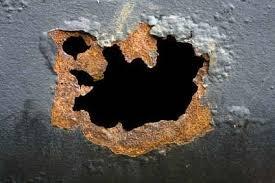One estimate is that corrosion costs the world economy the equivalent of over $2 Trillion US dollars per year. Another estimate claims that corrosion costs the US Department of Defense $22.5 Billion US dollars per year. Any way you slice it, corrosion is very expensive. All equipment and infrastructure is slowly rusting or decaying as you read this.
Fundamental Causes of Corrosion
There are a number of different types of corrosion. You can find descriptions of them at many other websites, so we will not review them here. Instead, it may be more effective to list two fundamental causes of corrosion damage as follows:
- People who don’t care to educate themselves about corrosion, because somebody else pays the financial penalty for their ignorance.
- Construction contracts, manufacturing contracts, and other situations which incentivize the use corrosive or corrodible materials. Usually this is because someone else ends up paying the financial penalty for ignoring the standards of their own industry.
Most Corrosion is Preventable
The British Navy has been performing corrosion research since 1763. Today, there are a number of qualified professionals who can identify corrosion solutions. Most corrosion is caused by the failure to implement industry standards. This situation is caused by ignorance and the fact that the entities or persons who design, inspect, and install infrastructure are not usually the same entities or persons who pay the cost of repairing it.
Some corrosion is caused by coatings failures. What at first appears to be peeling coatings from old age is most often the result of improper surface preparation prior to the application of the coatings. A coating is only as good as the surface preparation performed prior to the application of the coating. Improper surface preparation is almost always a failure to follow the written recommendations of the coatings manufacturer.
What at first appears to be crumbling concrete may be due to micro-biological-induced corrosion. One type of bacteria creates hydrogen-sulfide gas, then another type converts the gas into sulfuric acid which dissolves concrete. This corrosion is predictable and preventable.
What at first appears to be unavoidable rust is probably caused by using the wrong metals, or failing to install adequate corrosion-protection for the metals. If you see excessive corrosion of metals, some questions in your mind should be: “Who selected the metals? Who selected the coatings? Has anything changed since then? What did they know and when did they know it?”.
Although it is not cost-effective to entirely eliminate corrosion, the rate of corrosion can be greatly-reduced through conformance with industry standards with only a small additional cost. In some cases, different coatings or materials will reduce corrosion to an acceptable rate. In other cases, it may be more cost-effective to add some additional (sacrificial) material and allow it to corrode. When public safety is at stake, only qualified professionals should make decisions related to corrosion-resistance and sacrificial materials.
Resources for Further Research
Corrosion is a good subject for continuing research. However, everything we need to know to reduce the corrosion of to an acceptable level is already known in most cases. Check out the various corrosion entries in Wikipedia, and the following examples of standards if they are relevant to your situation:

- American Society for Testing and Materials (ASTM) Standard D3276 Standard Guide for Painting Inspectors (Metal Substrates).
- American Society for Testing and Materials (ASTM) Standard D6327 Standard Guide for Painting Inspectors (Concrete and Masonry Substrates).
- American Society for Testing and Materials (ASTM) Standard G162 Standard Practice for Conducting and Evaluating Laboratory Corrosion Tests in Soils.
- Naval Facilities Engineering Command (NAVFAC) Painting Handbook (NAVFAC P-710.0).
- Department of Defense (DOD) Protective Coatings and Paints (UFC 3-190-06).
- Department of Defense (DOD) Electrical Cathodic Protection (UFC 3-570-02N).
